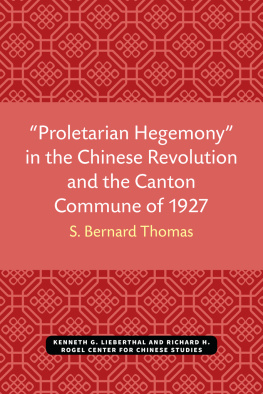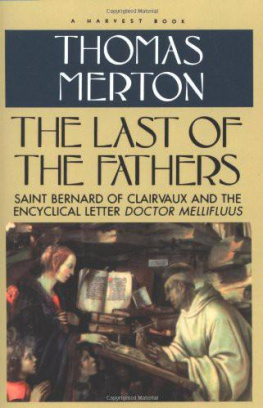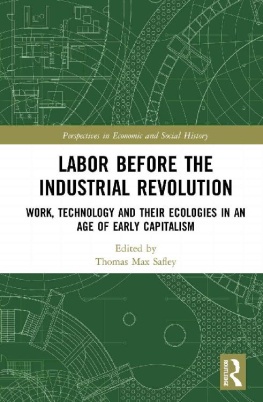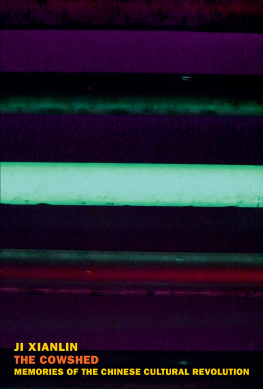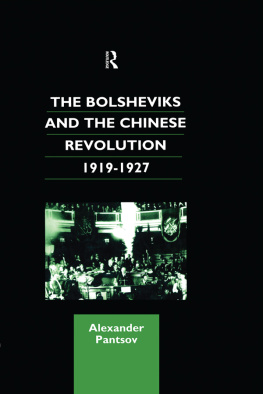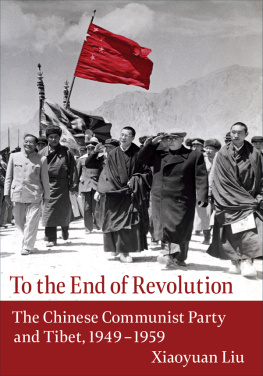S. Bernard Thomas - Labor and the Chinese Revolution
Here you can read online S. Bernard Thomas - Labor and the Chinese Revolution full text of the book (entire story) in english for free. Download pdf and epub, get meaning, cover and reviews about this ebook. year: 2020, publisher: Kenneth G. Lieberthal and Richard H. Rogel Center for Chinese Studies, genre: Politics. Description of the work, (preface) as well as reviews are available. Best literature library LitArk.com created for fans of good reading and offers a wide selection of genres:
Romance novel
Science fiction
Adventure
Detective
Science
History
Home and family
Prose
Art
Politics
Computer
Non-fiction
Religion
Business
Children
Humor
Choose a favorite category and find really read worthwhile books. Enjoy immersion in the world of imagination, feel the emotions of the characters or learn something new for yourself, make an fascinating discovery.

- Book:Labor and the Chinese Revolution
- Author:
- Publisher:Kenneth G. Lieberthal and Richard H. Rogel Center for Chinese Studies
- Genre:
- Year:2020
- Rating:3 / 5
- Favourites:Add to favourites
- Your mark:
- 60
- 1
- 2
- 3
- 4
- 5
Labor and the Chinese Revolution: summary, description and annotation
We offer to read an annotation, description, summary or preface (depends on what the author of the book "Labor and the Chinese Revolution" wrote himself). If you haven't found the necessary information about the book — write in the comments, we will try to find it.
Labor and the Chinese Revolution — read online for free the complete book (whole text) full work
Below is the text of the book, divided by pages. System saving the place of the last page read, allows you to conveniently read the book "Labor and the Chinese Revolution" online for free, without having to search again every time where you left off. Put a bookmark, and you can go to the page where you finished reading at any time.
Font size:
Interval:
Bookmark:

THE UNIVERSITY OF MICHIGAN
CENTER FOR CHINESE STUDIES
MICHIGAN MONOGRAPHS IN CHINESE STUDIES
NO. 49
LABOR AND
THE CHINESE REVOLUTION
CLASS STRATEGIES AND CONTRADICTIONS OF
CHINESE COMMUNISM, 1928-48
S. BERNARD THOMAS
Ann Arbor
Center for Chinese Studies
The University of Michigan
1983
Open access edition funded by the National Endowment for the Humanities/Andrew W. Mellon Foundation Humanities Open Book Program.
Copyright 1983
by
Center for Chinese Studies
The University of Michigan
Library of Congress Cataloging in Publication Data
Thomas, S. B. (S. Bernard), 1921
Labor and the Chinese revolution.
(Michigan monographs in Chinese studies; no. 49) Bibliography: p.
Includes index.
1. CommunismChinaHistory20th century. 2. Labor and laboring classesChinaHistory20th century. 3. PeasantryChinaHistory20th century. I. Title. II. Series.
HX417.T495 1983 335.430951 83-19045
ISBN 0-89264-049-9
ISBN: (ebook)
Jacket photograph: PLA troops entering Shanghai, 25 May 1949. Museum of Revolutionary History, Peking.
Printed in the United States of America
ISBN 978-0-89264-049-2 (hardcover)
ISBN 978-0-472-03841-1 (paper)
ISBN 978-0-472-12824-2 (ebook)
ISBN 978-0-472-90224-8 (open access)
The text of this book is licensed under a Creative Commons Attribution-NonCommercial-NoDerivatives 4.0 International License: https://creativecommons.org/licenses/by-nc-nd/4.0/
To Ruth, John and Ira
CONTENTS
In preparing this study I have had the support and assistance of many people and institutions. I am grateful to the staffs of the Hoover Library at Stanford University, the Harvard-Yenching Library at Harvard University, the China Documentation Center at Columbia University, the Kresge Library at Oakland University, and the Universities Service Centre in Hong Kong. I especially thank Mr. Wei-ying Wan and the staff of the Asia Library at the University of Michigan for their unfailing courtesies and help through the years of my research on the book. I have also been assisted by a number of grants and stipends from the Oakland University Research Committee, and I am particularly grateful to Professor Lewis N. Pino, former Director of Research and Academic Development at Oakland University for his many kindnesses and aid in facilitating my work and furthering the publication of this book.
Many friends and colleagues in the China field, as well as anonymous readers from the University of Michigan Center for Chinese Studies, read earlier drafts of the manuscript, and I have benefitted greatly from their suggestions and criticisms. Any remaining errors of fact or interpretation are my responsibility. Professor Robert C. Howes of Oakland University gave unstinting help in translating Russian sources, and my former colleague Mr. Shih-chen Peng gave generously of his time and linguistic skills in working with me on Chinese-language materials.
The late Marian P. Wilson, editorial assistant of the College of Arts and Sciences at Oakland University, working on the initial draft of the manuscript, and as a good friend and sharp critic did much to improve it. Her able successor, Anne H. Lalas, has been an invaluable editorial counsellor in taking the manuscript through further revisions and drafts. I am also indebted to Barbara Congelosi, former editor for the Center for Chinese Studies Publications, for her unsparing efforts in editing and preparing the manuscript for publication; to her successors Janis Michael and Janet Opdyke who so ably and efficiently took charge of all final editorial and production details; and to Diane Scherer, who typed and processed the copy for the printer.
I wish also to give my special thanks to Dr. Harvey A. Lincoff, a most distinguished retinal surgeon, whose extraordinary skills and concern have literally given me the gift of sight, without which this book and much else would have been impossible. My wife Evelyn, as always, has been an indispensable source of loving help and encouragement.
S. Bernard Thomas
Oakland University
Rochester, Michigan
August 1983
| ACFL | All China Federation of Labor |
| CAL | China Association of Labor |
| CBSA | Central Bureau of the Soviet Areas |
| CCP | Chinese Communist Party |
| CI | Comintern (Communist International) |
| ECCI | Executive Committee, Communist International |
| ILO | International Labor Organization |
| KMT | Kuomintang (Nationalist Party) |
| NCNA | New China News Agency |
| PLA | Peoples Liberation Army |
| RILU | Red International of Labor Unions (Profintern) |
| WFTU | World Federation of Trade Unions |
Note. While the pinyin romanization system adopted by the Peoples Republic of China is now becoming the standard system for transcribing Chinese, I have somewhat reluctantly continued to use the older Wade-Giles form. I do this because my study deals with a period for which virtually all the English-language sources and translations cited and quoted use the latter system. However, for all Chinese names and places listed in the index, the pinyin equivalent has been provided in brackets. Pinyin romanization has also been used for current citations of journal titles now known in that form: Beijing review, Renmin ribao, [Peoples Daily], Gongren ribao [Worker], Guangming ribao [Bright Daily], and for the news service, Xinhua [NCNA].
The two decade period from 1928 through 1948 witnessed a remarkable reversal of fortune for the Chinese Communist revolutionary movement. It began in the wake of the enforced retreat of the shattered Communist remnants from the countryside and ended with the final triumphant return to those cities by the Communist-led peasant forces of the Peoples Liberation Army (PLA). The once powerful left labor movement of the mid-1920s had suffered an all but fatal blow in the succession of disasters that befell the CCP in the 1927 dissolution of the first KMT-CCP united front. But though the Communist-led labor movement never recovered its former momentum and influence during the subsequent twenty years of revolutionary struggle, the partys assessment and handling of labors role in the revolution remained an important and often crucial ingredient in CCP doctrinal, strategic, and policy formulations in those years, as well as in the leadership conflicts which developed from these formulations.
The above issues and conflicts were evident in the agrarian revolutionary line of the party, in its rural-urban strategic concepts and class policies, in united front issues, in questions of revolutionary stages and class leadership, and in the economic and developmental policies pursued in Communist-controlled areas. The role assigned to labor continued to be a critical touchstone, whether in the efforts to accentuate and reinforce the partys proletarian base and character in the decade following 1928 or, conversely, in the moves during the subsequent ten years to forge new policies and strategies which in effect restructured and redefined the class contours of Chinese Communism. One may indeed question whether labors narrow class interests were compatible with those of a peasant-based social revolution or with the developmental needs of the massive and poverty-stricken rural society that was China.
Next pageFont size:
Interval:
Bookmark:
Similar books «Labor and the Chinese Revolution»
Look at similar books to Labor and the Chinese Revolution. We have selected literature similar in name and meaning in the hope of providing readers with more options to find new, interesting, not yet read works.
Discussion, reviews of the book Labor and the Chinese Revolution and just readers' own opinions. Leave your comments, write what you think about the work, its meaning or the main characters. Specify what exactly you liked and what you didn't like, and why you think so.

